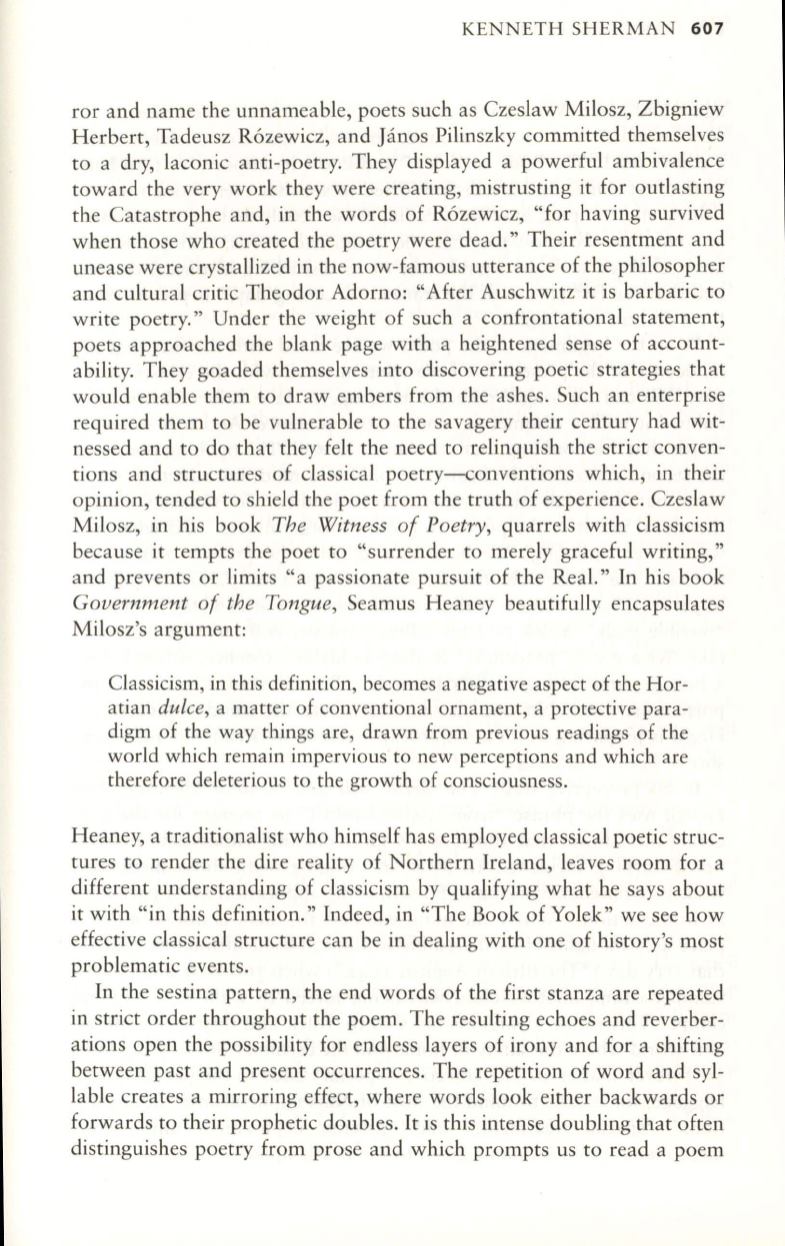
KEN ETH SHERMAN
607
ror and name the unnameable, poets such as Czeslaw Milosz, Zbigniew
Herbert, Tadeusz R6zewicz, and Janos Pilinszky committed themselves
to a dry, laconic anti-poetry. They displayed a powerful ambivalence
toward the very work they were creating, mistrusting it for outlasting
the Catastrophe and, in the words of R6zewicz, "for having survived
when those who created the poetry were dead." Their resentment and
unease were crystallized in the now-famous utterance of the philosopher
and cultural critic Theodor Adorno: "After Auschwitz it is barbaric to
write poetry." Under the weight of such a confrontational statement,
poets approached the blank page with a heightened sense of account–
ability. They goaded themselves into discovering poetic strategies that
would enable them to draw embers from the ashes. Such an enterprise
required them to be vulnerable to the savagery their century had wit–
nessed and to do that they felt the need to relinquish the strict conven–
tions and structures of classical poetry-conventions which, in their
opinion, tended to shield the poet from the truth of experience. Czeslaw
Milosz, in his book
The Witness of Poetry,
quarrels with classicism
because it tempts the poet to "surrender to merely graceful writing,"
and prevents or limits "a passionate pursuit of the Real." In his book
Government of the Tongue,
Seamus Heaney beautifully encapsulates
Milosz's argument:
Classicism, in this definition, becomes a negative aspect of the Hor–
atian
dulce,
a matter of conventional ornament, a protective para–
digm of the way things are, drawn from previous readings of the
world which remain impervious
to
new perceptions and which are
therefore deleterious
to
the growth of consciousness.
Heaney, a traditionalist who himself has employed classical poetic struc–
tures to render the dire reality of Northern Ireland, leaves room for a
different understanding of classicism by qualifying what he says about
it with "in this definition." Indeed, in "The Book of Yolek" we see how
effective classical structure can be in dealing with one of history's most
problematic events.
In the sestina pattern, the end words of the first stanza are repeated
in strict order throughout the poem. The resulting echoes and reverber–
ations open the possibility for endless layers of irony and for a shifting
between past and present occurrences . The repetition of word and syl–
lable creates a mirroring effect, where words look either backwards or
forwards
to
their prophetic doubles .
It
is this intense doubling that often
distinguishes poetry from prose and which prompts us to read a poem


